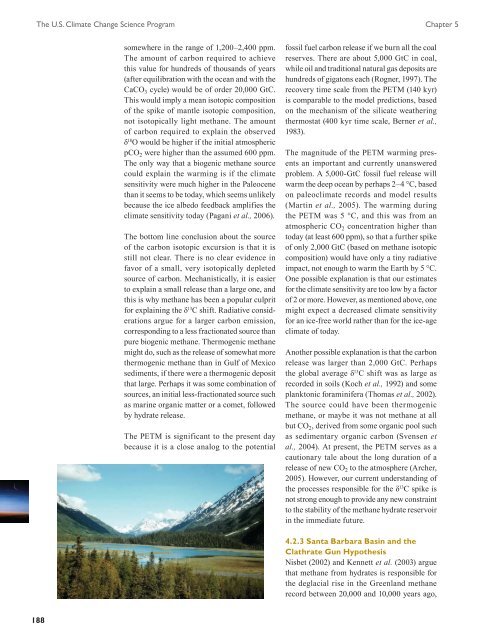Book 2.indb - US Climate Change Science Program
Book 2.indb - US Climate Change Science Program
Book 2.indb - US Climate Change Science Program
- No tags were found...
Create successful ePaper yourself
Turn your PDF publications into a flip-book with our unique Google optimized e-Paper software.
The U.S. <strong>Climate</strong> <strong>Change</strong> <strong>Science</strong> <strong>Program</strong> Chapter 5corp1313.jpgsomewhere in the range of 1,200–2,400 ppm.The amount of carbon required to achievethis value for hundreds of thousands of years(after equilibration with the ocean and with theCaCO 3 cycle) would be of order 20,000 GtC.This would imply a mean isotopic compositionof the spike of mantle isotopic composition,not isotopically light methane. The amountof carbon required to explain the observedδ 18 O would be higher if the initial atmosphericpCO 2 were higher than the assumed 600 ppm.The only way that a biogenic methane sourcecould explain the warming is if the climatesensitivity were much higher in the Paleocenethan it seems to be today, which seems unlikelybecause the ice albedo feedback amplifies theclimate sensitivity today (Pagani et al., 2006).The bottom line conclusion about the sourceof the carbon isotopic excursion is that it isstill not clear. There is no clear evidence infavor of a small, very isotopically depletedsource of carbon. Mechanistically, it is easierto explain a small release than a large one, andthis is why methane has been a popular culpritfor explaining the δ 13 C shift. Radiative considerationsargue for a larger carbon emission,corresponding to a less fractionated source thanpure biogenic methane. Thermogenic methanemight do, such as the release of somewhat morethermogenic methane than in Gulf of Mexicosediments, if there were a thermogenic depositthat large. Perhaps it was some combination ofsources, an initial less-fractionated source suchas marine organic matter or a comet, followedby hydrate release.The PETM is significant to the present daybecause it is a close analog to the potentialfossil fuel carbon release if we burn all the coalreserves. There are about 5,000 GtC in coal,while oil and traditional natural gas deposits arehundreds of gigatons each (Rogner, 1997). Therecovery time scale from the PETM (140 kyr)is comparable to the model predictions, basedon the mechanism of the silicate weatheringthermostat (400 kyr time scale, Berner et al.,1983).The magnitude of the PETM warming presentsan important and currently unansweredproblem. A 5,000-GtC fossil fuel release willwarm the deep ocean by perhaps 2–4 °C, basedon paleoclimate records and model results(Martin et al., 2005). The warming duringthe PETM was 5 °C, and this was from anatmospheric CO 2 concentration higher thantoday (at least 600 ppm), so that a further spikeof only 2,000 GtC (based on methane isotopiccomposition) would have only a tiny radiativeimpact, not enough to warm the Earth by 5 °C.One possible explanation is that our estimatesfor the climate sensitivity are too low by a factorof 2 or more. However, as mentioned above, onemight expect a decreased climate sensitivityfor an ice-free world rather than for the ice-ageclimate of today.Another possible explanation is that the carbonrelease was larger than 2,000 GtC. Perhapsthe global average δ 13 C shift was as large asrecorded in soils (Koch et al., 1992) and someplanktonic foraminifera (Thomas et al., 2002).The source could have been thermogenicmethane, or maybe it was not methane at allbut CO 2 , derived from some organic pool suchas sedimentary organic carbon (Svensen etal., 2004). At present, the PETM serves as acautionary tale about the long duration of arelease of new CO 2 to the atmosphere (Archer,2005). However, our current understanding ofthe processes responsible for the δ 13 C spike isnot strong enough to provide any new constraintto the stability of the methane hydrate reservoirin the immediate future.4.2.3 Santa Barbara Basin and theClathrate Gun HypothesisNisbet (2002) and Kennett et al. (2003) arguethat methane from hydrates is responsible forthe deglacial rise in the Greenland methanerecord between 20,000 and 10,000 years ago,188






